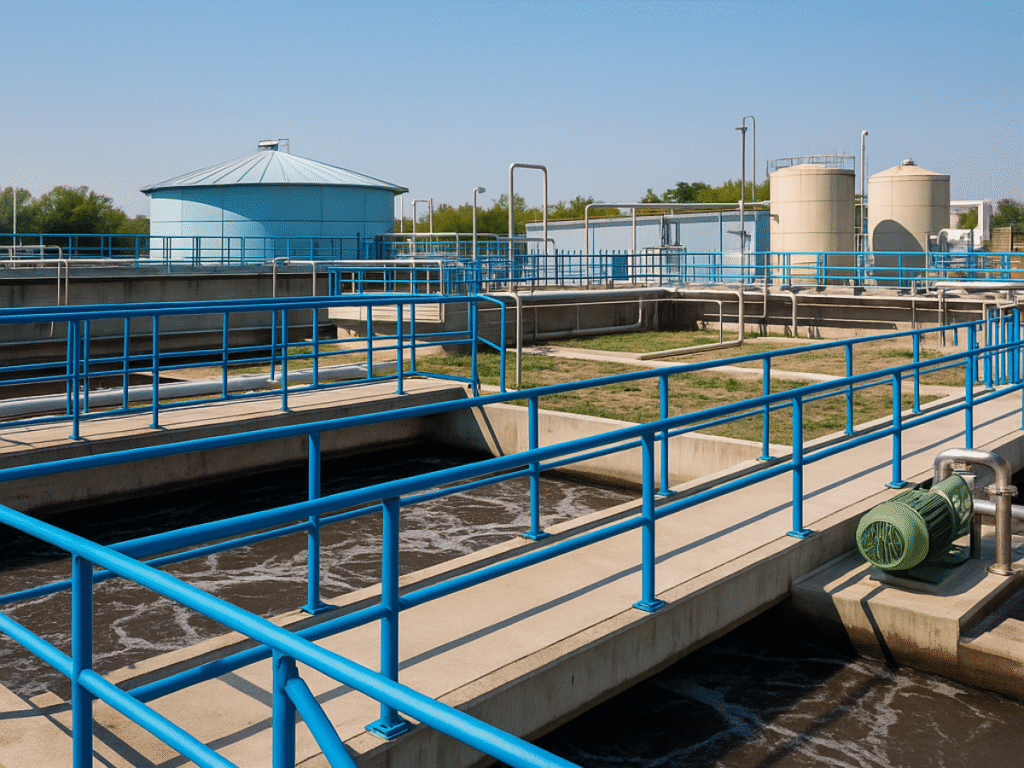Designing an Efficient ETP: Factors to Consider

By Fluvyl, updated July 7, 2025

Synopsis
Learn how to design an Effluent Treatment Plant (ETP) efficiently by understanding key factors such as site assessment, flow rate, influent quality, treatment goals, and cost-effective principles.
Effluent Treatment Plants (ETPs) are critical for managing industrial wastewater before it is released into the environment or reused. A well-designed ETP not only helps industries comply with environmental regulations but also minimizes operational costs and supports sustainability.
But here’s the catch: designing an efficient ETP isn’t just about putting together a few tanks and pumps. It’s a thoughtful process that starts with understanding your site, water flow, and contaminants—and ends with a plant that’s smart, scalable, and sustainable.
In this blog, we’ll break down the key factors you must consider when designing an efficient ETP. Whether you’re an environmental engineer, plant manager, or business owner, this guide will help you make informed decisions and avoid common mistakes.
1. Site Assessment: Where It All Begins
Before diving into the design process, conducting a thorough site assessment is essential. The site directly impacts the layout, construction, and even the type of treatment technologies used.
Key Considerations:
- Topography: Natural slopes can reduce pumping costs.
- Available space: Influences whether you opt for compact or extensive systems.
- Soil characteristics: Impacts construction feasibility and groundwater safety.
- Accessibility: Proximity to power supply, roads, and discharge points.
- Climate: Temperature and rainfall affect treatment efficiency and plant durability.
💡 Tip: Don’t underestimate seasonal factors—like monsoon runoff or winter freezing—that can impact treatment operations.
2. Understanding Flow Rate: The Heartbeat of the ETP
The flow rate is like the heartbeat of your wastewater system. It tells you how much water your ETP needs to treat—and when.
There are two main types of flow rates you need to analyze:
- Average Daily Flow (ADF): The mean volume of wastewater over a 24-hour period.
- Peak Flow: Maximum flow observed during peak operations.
Why Flow Rate Matters:
- Sizing: Determines tank volumes, pump capacities, and pipe diameters.
- Shock Load Handling: Helps in designing buffers or equalization tanks to prevent overloads.
- Energy Efficiency: Right-sized systems consume less energy and lower operational costs.
📌 Pro tip: Always include a flow equalization tank to balance irregular inflow patterns.
3. Influent Quality: Know Your Wastewater
You can’t treat what you don’t understand. Knowing what’s in your influent (incoming wastewater) is vital to choosing the right treatment methods.
Key Parameters to Measure:
| Parameter | Why It’s Important | Typical Source |
|---|---|---|
| pH | Affects chemical dosing and microbes | Acidic/alkaline discharges |
| BOD (Biochemical Oxygen Demand) | Indicates organic load | Food, pharma, textile |
| COD (Chemical Oxygen Demand) | Total oxidizable material | Industrial chemicals |
| TSS (Total Suspended Solids) | Can clog filters and pumps | Manufacturing effluent |
| Heavy Metals | Toxic to aquatic life | Electroplating, paint |
| Oil & Grease | Can foul membranes | Automotive, food |
⚠️ Note: Regular sampling at different times is crucial to understand fluctuations in influent quality.
4. Defining Treatment Goals: Compliance and Beyond
What do you want your ETP to achieve?
Common Goals:
- Regulatory Compliance: Meet CPCB/SPCB discharge norms.
- Water Reuse: Treat water to a level suitable for reuse in processes, cooling, or gardening.
- Zero Liquid Discharge (ZLD): Ensure no wastewater leaves the facility.
- Cost Minimization: Optimize design to reduce capital and O&M expenses.
Different goals require different levels of treatment:
| Goal | Required Treatment Stage |
|---|---|
| Discharge to sewer | Primary + Secondary |
| Discharge to surface water | Primary + Secondary + Tertiary |
| Reuse | Secondary + Tertiary + Disinfection |
| ZLD | Full treatment + RO + Evaporation/Crystallization |
5. Choosing the Right Treatment Technologies
Once you know your flow and influent quality, it’s time to select the most suitable treatment technologies.
Treatment Stages:
- Preliminary Treatment – Screens, grit chambers to remove large solids.
- Primary Treatment – Sedimentation tanks to remove settleable solids.
- Secondary Treatment – Biological processes (like ASP, MBBR, SBR) to remove organic load.
- Tertiary Treatment – Filters, RO, or UV for polishing and reuse.
- Sludge Handling – Dewatering, drying beds, or mechanical presses.
Choosing Between Common Systems:
| System | Best For | Pros | Cons |
|---|---|---|---|
| Activated Sludge (ASP) | Large plants | Proven, effective | High O&M |
| MBBR (Moving Bed Biofilm Reactor) | Medium loads | Compact, stable | Media cost |
| SBR (Sequencing Batch Reactor) | Variable flows | Flexible, space-saving | Batch operation |
| Membrane Bioreactor (MBR) | High-quality reuse | Excellent effluent quality | High cost |
6. Energy and Chemical Efficiency
Efficiency isn’t just about treatment performance—it’s also about costs.
Reduce Energy Consumption by:
- Using gravity wherever possible.
- Installing VFDs (Variable Frequency Drives) on motors and pumps.
- Aeration systems with timers or DO feedback.
Reduce Chemical Usage by:
- Optimizing pH control through automation.
- Using natural coagulants (e.g., chitosan) when possible.
- Recirculating treated water to reduce fresh water intake.
7. Automation and Monitoring: Smart ETPs Are the Future
Gone are the days of manual sampling and guesswork. Today, smart ETPs use SCADA systems, IoT-based sensors, and real-time dashboards.
Benefits:
- Real-time monitoring of flow, pH, DO, etc.
- Alerts and alarms for system failures.
- Data logs for audits and compliance.
- Remote access and control via mobile.
Even if full automation isn’t in your budget, start with basic sensors and loggers. You can upgrade later.
8. Sludge Management: Often Ignored but Crucial
What happens to the solids separated during treatment? That’s sludge, and improper handling can create compliance issues.
Sludge Management Steps:
- Thickening – Concentrating sludge to reduce volume.
- Dewatering – Removing water using filter press, belt press, or centrifuges.
- Drying – Open beds or mechanical dryers.
- Disposal or reuse – Composting, incineration, or use in construction.
9. Cost-Effective Design Principles
Let’s face it—budget is a big deal. But cost-effective doesn’t mean cheap.
Here’s how you can design smart without cutting corners:
- Modular Design: Add capacity later without overhauling the whole system.
- Gravity Flow: Reduces pumping needs.
- Reuse Treated Water: Cuts down water purchase costs.
- Use Local Materials: Reduces logistics and speeds up construction.
- Proper Sizing: Oversizing = unnecessary costs; undersizing = frequent breakdowns.
10. Plan for Maintenance and Staffing
Even the best ETP will fail without trained operators and a maintenance plan.
- Provide space for walkways and maintenance access.
- Include safety features like railings, emergency showers, and signage.
- Develop SOPs (Standard Operating Procedures) for daily, weekly, and monthly tasks.
- Schedule periodic training sessions for plant operators.
Final Thoughts: Think Long-Term
Designing an efficient ETP is a long-term investment. It’s about protecting the environment, meeting regulations, and managing costs responsibly. When designed right, your ETP can become a value generator—cutting down on fresh water costs, improving brand image, and ensuring business continuity.
Ready to Design Your ETP?
If you’re embarking on your ETP journey, now you know where to begin. Prioritize data collection, involve the right experts, and design for both performance and practicality. And if you’re looking for expert guidance, design tools, or training—don’t hesitate to contact us.
